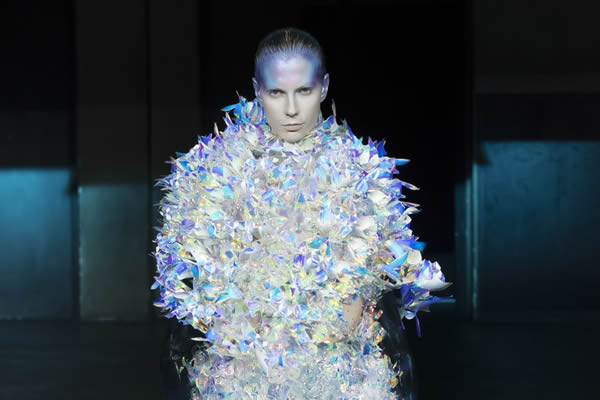Japanese fashion designer Yuima Nakazato has used Fujifilm’s Acuity Select 20 large-format UV inkjet printer, together with high-elongation Uvijet KV ink, to create a stunning dress for the Paris Haute Couture Collection.
 The piece is made up of small coloured cells that make it like look like folded paper cranes have flocked together. These cells use holographic material developed over six years of research with a hologram manufacturer. Images are printed on the material using the Fuji printer and inks stated above.
The piece is made up of small coloured cells that make it like look like folded paper cranes have flocked together. These cells use holographic material developed over six years of research with a hologram manufacturer. Images are printed on the material using the Fuji printer and inks stated above.
To create a single cell, an A5-sized piece of printed material is cut using a plotter. Each individual unit is carefully folded into shape, as with origami. More than 1,000 of these units, folded by approximately 100 staff, are combined and assembled to match the model's figure. In this way, without using a loom, fabric, or any stitching, a single dress is created.
Leading Fujifilm's technical support to Nakazato was the Open Innovation Hub (OI-Hub), launched in 2014 as a place for collaborative value creation from Fujifilm Group's resources including technologies, products and materials.
Previously, it was only thought possible to create four different types of colours using holographic fabric, but via experimentation, Fujifilm developed a method of printing graphics on a composite transparent backing material using Uvijet KV ink.
Nakazato said of the project: “Previously, I have focused on holograms and repeated various kinds of research, but I was able to achieve my goals by focusing not on the textiles but on the film. I'm very grateful to Fujifilm for this collaboration. I had always wanted to expand the expressive range of holograms, but as the surfaces of films are extremely smooth, there was always an issue of getting the ink to adhere even if you could print on the film. What's more, as we're using this material for fashion, there is a lot of friction and it needs to be extremely robust.
“Through the technology that Fujifilm have contributed to this project, they have shown that their ink fixes extremely well and that if, after printing, you cut the material with a plotter or form it into units by hand, there are no problems such as ink detachment and robustness is extremely high. In addition to dresses, I also created some boots that use a holographic print created from photographs of the ice in Iceland, and here too the reproduction of the colours is extremely high-quality and the print looks just how I want it to. I don't think there is any other company with the technology to achieve this combination of quality and strength.
“There were actually even more technologies and special films Fujifilm introduced to me that I did not get the chance to use due to time constraints, so I am extremely interested in continuing this collaboration”.

